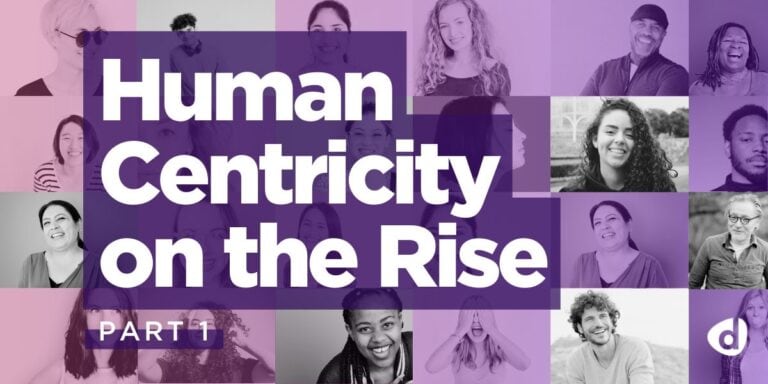Human Centricity on the Rise: Navigating the New Era, Part 1

Unpacking the 2024 GRIT Insights Practice Report: Key Takeaways and Trends for Qualitative Research
The consumer insights industry is experiencing a period of rapid transformation. The 2024 GRIT Insights Practice Report sheds light on key trends and challenges shaping the future of insights, drawing from data gathered in Q4 of 2023 from global insights professionals, covering both brand-side and supplier-side perspectives.
As a part of Discuss’ new blog series, Human Centricity on the Rise, this blog will explore the GRIT’s report findings — focusing on trends and challenges shaping the future of human-centric qualitative insights.
Overall Industry “Buzz” Topics & Trends
The industry is buzzing with discussions on AI, human-centric methodologies, analytics, and automation. All these hot topics are really about one thing: making our work more efficient and impactful. The GRIT report highlighted a lot of industry chatter around:
Challenges with the time required for running research projects.
Since 2018, GRIT has tracked how insights professionals allocate their time across the research projects. This year’s report reveals that significant time-consuming activities for these professionals include planning and designing research, managing projects, and preparing deliverables. While this is not a groundbreaking discovery, it highlights a common challenge: organizations are often getting bottlenecked by the logistics of research, delaying the time to insights.
Synthetic data is the next big thing in GenAI.
Synthetic Sample is an AI simulated segment that can accurately replicate real people’s attitudes, opinions, and behaviors. It is best used to provide early indicators that inform how to get the most out of your research.
This emerging methodology addresses some of the historical challenges in the industry like sample quality, escalating costs, and (as mentioned above) time-intensive data collection and analysis. While still emerging, it’s gaining traction across sectors of the insights industry with the Qualitative Research segment reporting a 28% increase in use of synthetic sample since last year.
There’s a lot of potential for synthetic sample to fill in gaps to supplement research, but it’s important to use it as just that – a supplement to human sample and to validate it, building it on a foundation of real conversations with real people.

Expanding qualitative research methods with AI.
The GRIT report mentions that AI is “making people imagine possibilities, and qualitative research has that in spades.” We’re seeing insights professionals increasingly integrating AI to analyze qualitative data, not only to boost efficiency but also to provide more impactful analysis. They’re using AI to analyze data beyond traditional focus groups and IDIs, and tapping into other data sources, like video and images, to uncover richer insights.
“If the industry pays attention to those who are drunk on AI, it is doomed. If the industry soberly applies AI to the buzz topics, the sky isn’t the limit. No one knows the limit.”
Data quality and privacy concerns and opportunities with AI.
Data quality, privacy, and security are top-of-mind concerns, with AI being both a potential problem and a solution in these areas. When working with a provider that uses AI, it’s important to ask how the tool ensures data confidentiality.
While synthetic samples raise concerns, it can help address many privacy issues and limitations associated with traditional data methods by generating data that imitates real user behaviors and attributes without using actual user data. This approach offers a way to actually enhance privacy while still maintaining high data quality.
The most important takeaway here is making sure you understand how these next gen technologies are implemented to ensure both quality and privacy for your data.
Top 3 Qualitative Research Trends
1. Evolving qualitative research methodologies
The GRIT Report discusses which methodologies are used most and have the most momentum in each GRIT segment. In the qualitative research space, we are seeing the following trends:
Live webcam focus groups and in-depth interviews (IDIs) are the most-used methodology and mobile qual is becoming more prominent to gain human-centric insights.
What better way to understand a consumer than speaking to them directly – hearing their stories first-hand, experiencing their raw emotions, and taking a seat at their table to truly LISTEN. Gone are the days when qualitative research was used to make people want things; now, these insights guide organizations to create things people want.
The rise of mobile qual is unlocking the ability to speak to consumers more often, more genuinely, and more comfortably. With this approach, consumers can share their opinions, perspectives, and preferences from the convenience of their mobile device, while researchers get a glimpse into consumers’ lives by observing their behaviors and activities.
Not only that, but in our world that is increasingly digitized and connected, being able to speak with consumers, whether through live interviews or asynchronously, allows organizations to reach a greater global audience, scaling their human centricity broader than ever before.
Insights professionals are consolidating their qualitative tech stack.

Tech that’s connected to all parts of the research lifecycle is now a must-have. The GRIT Report found that the use of marketplaces, or all-in-one solutions, increased in every professional segment they studied, except technology, where they were already common.
Researchers are frustrated with the inconvenience and inefficiency of juggling multiple platforms for their research. From live interviews to asynchronous research to all of the previously recorded research that has been sitting on a digital “shelf”, unusable – the industry is demanding consolidation and greater efficiency. This trend of consolidation also enhances data privacy and security. By centralizing access permissions, researchers can better safeguard confidential data, avoiding the risks associated with scattering sensitive information across multiple platforms or storage locations.
At Discuss, we believe market research has entered a new era – one that is characterized by greater data volumes, rapidly advancing next-gen technologies, and consumer behaviors that are evolving faster than ever before. As insights professionals strive to keep pace, they not only need efficient and scalable tools, but solutions that make it easy to integrate consumer voices across the entire product lifecycle – from ideation development to understanding the user experience and looking for unmet needs.
I share more about this trend of tech consolidation in my recent Forbes Tech Council article, How All-In-One Solutions Are Shaping Modern Business Operations.
2. Changing expectations to do qual faster, better AND cheaper
In a recent blog, our Chief Growth Officer, Adam Mertz, spoke to the idea that we have to recognize that “faster, better, and cheaper are not mutually exclusive—that true innovation lies in finding the delicate balance between speed, quality, and cost-effectiveness.”
The GRIT Report highlights how insights groups are facing intense pressure to deliver insights faster and at a lower cost. This is creating a dilemma for suppliers who need to balance quality research with winning business because while achieving “faster” and “cheaper” outcomes are measurable, maintaining a standard of “better” insights is quite subjective and is frequently compromised in the pursuit of efficiency.
Suppliers must offer purpose-built tools that make the analysis and sharing of human-centric insights a breeze. They need tools like GenAI that can provide detailed and accurate recaps, summaries, themes, and quotes from research on a global scale and align findings with specific research objectives.
The point here is, that while saving time and money is important, it becomes irrelevant if the data cannot be easily interpreted and shared.
3. Increased investment in DIY solutions to be more consumer-centric
While still an incredibly valuable approach, the GRIT report findings show that full-service research yields the highest total cost and the slowest speed of results. Given the pressures to conduct agile qualitative research, we’re seeing organizations increasingly bringing their qual in-house and adopting a DIY approach. The Qualitative Research segment reported a 42% increase in the use of DIY solutions compared to 2023.
Organizations are building their own capabilities by investing in all-in-one solutions. These tools enable them to take a more hands-on approach to owning their data – unlocking deeper human-centricity by basing business decisions on their real first-hand interactions with their consumers rather than relying on third-party reports.
By investing in the right DIY tools, organizations are not only getting closer to their consumers but also embracing the trend of consolidation – bringing every facet of their qual under one roof – from live and asynchronous interviews to Gen-AI powered analysis and video editing tools.
And at the heart of it all…
I have many thoughts about the findings of this report—thoughts that could extend far beyond this blog. But fundamentally, what we’re really talking about here isn’t just qualitative research, it’s about the insights industry demanding easier ways to bring human centricity, at scale, to the heart of strategic initiatives.
At Discuss, we’re excited to be at the forefront of driving next gen human centricity with our:
- Next Gen Technology – Our innovative suite of GenAI tools enable researchers to scale qual like never before and make human-centric decisions, faster.
- Global Research Hub – With one purpose-built platform that supports the entire qualitative research life cycle.
- Unlimited Research Model – Empowering more people to do more qual and gain insights from more markets.
The 2024 GRIT Insights Practice Report paints a vivid picture of an industry in transformation, where technology is empowering faster, more insightful qualitative research while balancing the demands for efficiency and cost-effectiveness. As organizations strive to integrate deeper human centricity into their strategic initiatives, the future demands innovative solutions that bridge the gap between consumer insights and actionable decision-making.
Talk to an expert today to transform your insights into powerful, human-centric strategies that drive action and deliver results.
About Jim Longo:
Jim Longo is the Co-Founder and Chief Strategy Officer at Discuss, a purpose-built qualitative research platform for insights teams. He brings 35 years of domain expertise in the market research industry. Jim has consulted with brands and research agencies around the world on how to have insightful online conversations. Jim is considered a thought leader with regards to online behavior and market research technology. Connect with Jim on LinkedIn.
Ready to unlock human-centric market insights?
Related Articles

Why Your Business Needs a Multicultural Marketing Strategy
A recent Ad Age article highlights a notable trend that some companies are taking a stand to keep DEI at…
A recent Ad Age article highlights a notable trend that some companies are taking a stand to keep DEI at…

Human Centricity on the Rise: Navigating the New Era, Part 3
How to unlock human centricity at scale with a key mindset shift In Part 1 of this blog series, I…
How to unlock human centricity at scale with a key mindset shift In Part 1 of this blog series, I…

Empathy & Human Centricity Design | Discuss
By Adam Mertz, Chief Growth Officer at Discuss Introduction I recently had the opportunity to moderate a compelling discussion between…
By Adam Mertz, Chief Growth Officer at Discuss Introduction I recently had the opportunity to moderate a compelling discussion between…
